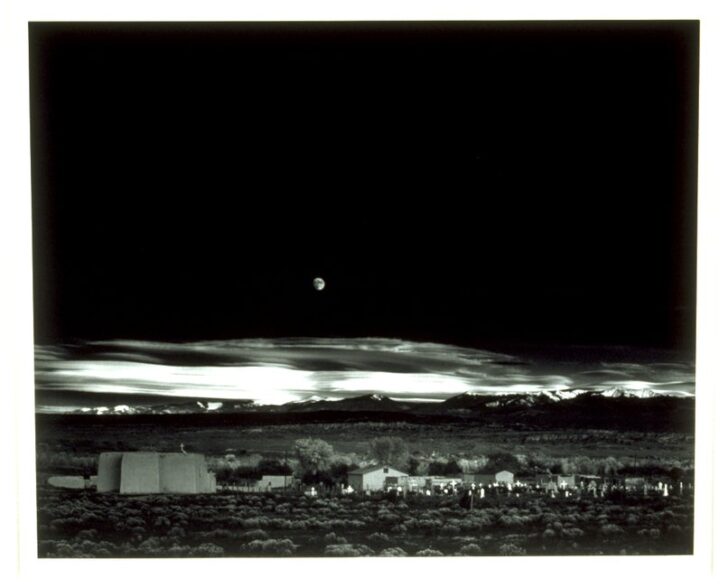Moonrise, Hernandez, New Mexico
Ansel Adams

Description
In the late afternoon of November 1, 1941, Ansel Adams was driving south along Highway 84 in northern New Mexico. With him in the big Pontiac station wagon were his eight-year-old son, Michael, and his good friend, Cedric Wright. Adams was working at the time for the U.S. Department of the Interior, which had hired him to produce a series of photographic murals for its offices in Washington, D.C. After a frustrating day along the Chama River, he had given up and was heading back toward Santa Fe.
The sun was traveling a low arc across the sky on that fall afternoon, creating long shadows on the mesas of the Rio Grande Valley. As the trio rolled south approaching the village of Hernandez, Adams glanced to his left and saw the moon rising above a band of cirrus clouds and the snow-covered peaks of the Sangre de Cristo range. In the foreground were the town's church and graveyard, their crosses brilliantly illuminated by the setting sun. He pulled off the road in a swirl of dust and flying gravel and rushed to the back of the car to unload his equipment. He quickly had the tripod out, and unwieldy 8x10 view camera set up, and the image framed on the ground glass. He knew immediately what he was after. Envisioning a darkened sky beyond the glow of the village, he slipped a deep yellow filter into the holder before the lens. The crucial decision now was to determine exposure and development, but in his haste to set up his camera he had left his light meter in the car. While his companions went searching, Adams grew desperate. The sun was edging toward a bank of clouds in the west, and he feared that at any moment the shadow would fall across the glowing crosses.
Years of experience came to the rescue, however, as he recalled that the luminance of the moon in a clear sky is approximately 250 candles per square foot. Using the exposure system he had recently developed, Adams placed this value on the Zone VII, toward the white end of the ten-step scale but not so bright as to wash out the details of the lunar surface. He was concerned that the brightness range of the scene might be too extreme and consequently made a note to process the negative by a diluted water bath" method to compress the density range and preserve detail in the dark areas of the foreground.
Adams realized immediately that he had made an important photograph and decided to expose a duplicate negative for safety's sake. He reversed the film holder, pulled the shielding slide from in front of the film plane, and looked up in anticipation of releasing the shutter, only to see that the bright sunlight had vanished from the crosses. The magical instant had passed.
In his early prints of the now classic "Moonrise, Hernandez, New Mexico," Adams left the sky a middle gray with several bands of light clouds in the upper portions of the frame. In later years he increased the exposure to these areas to render the sky a deep velvet black. "Moonrise" represents the product of a series of conscious interpretive decisions by the photographer, not simply a record of a beautiful scene. At each stage of the process Adams applied his technical mastery of the medium to create an image that would convey the emotions that he felt on that highway in New Mexico in 1941."
exerpt from: Spaulding, Jonathan. "Ansel Adams and the American Landscape: A Biography". Berkeley: University of California Press, 1995, xi-xii.
Subject Matter:
This photograph depicts a wide view of a flat, desert landscape underneath a darkening sky. Slightly off-center, a nearly full, waxing gibbous moon rises in the deepening dusk light. The composition is made of a series horizontal tonal bands that stretch across the picture. Beneath the moon, a tremulous swath of clouds streaks above a line of snowcapped mountains. Below, in a field populated with desert plants and bushes, a cluster of small buildings occupies the foreground. One of the buildings is a modest adobe church with a white cross mounted atop its entrance, which is echoed by the numerous crosses dotting the cemetery to its right. The crosses and tombstones gleam brightly in the waning light. The broad range of tones throughout the image speak to the fleeting transition from day to night, and the overall stillness of the scene emphasizes the grand, atmospheric and celestial motions of the universe.
Physical Description:
Photographed at dusk, this image depicts a waxing gibbous moon rising above a flat, desert landscape. In the foreground, along with some other small structures and trees, is a small church and a cemetery.
Usage Rights:
If you are interested in using an image for a publication, please visit https://umma.umich.edu/request-image/ for more information and to fill out the online Image Rights and Reproductions Request Form.